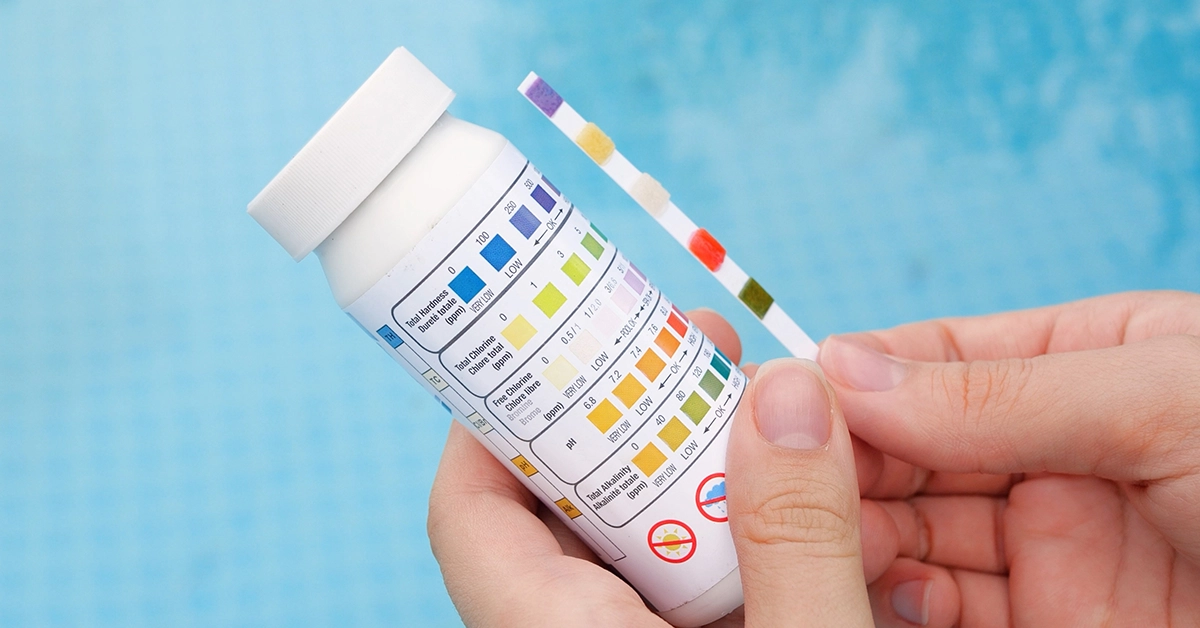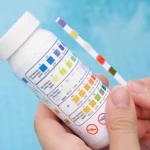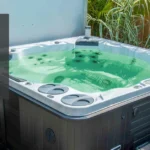Keeping the ideal pH balance for your hot tub can seem like an ongoing struggle, particularly if you want to avoid strong chemicals that might irritate your skin and compromise your spa equipment. You’re in the right place if you’ve been battling excessive pH levels and wondered how to naturally lower pH in hot tub.
Without sacrificing your health or the lifetime of your hot tub, this thorough book will coach you through tried-true natural approaches to attain ideal hot tub water chemistry. These natural remedies can help you keep absolutely clean, perfectly balanced water whether your water is foggy, scaled, or less sanitizer effective.
Hot Tub pH and Alkalinity: The Basis of Water Chemistry
pH in Hot Tub Water:
- On a range of 0 to 14, pH gauges the basic or acidic nature of your hot tub water.
- Hot tub optimal pH ranges from 7.2 to 7.8; 7.4 is the sweet spot that best fits human tears and mucous membranes.
The Part Alkalinity Plays in Hot Tub Maintenance
- As a pH buffer, total alkalinity helps to prevent fast variations that can harm machinery and annoy bathers.
- Hot tubs should have appropriate alkalinity levels kept between 80 and 120 ppm (parts per million).
How Alkalinity and pH Combine
- Higher alkalinity results in more stable pH but more difficult adjustment.
- Low alkalinity = erratic pH bouncing around
- Stable water chemistry and simple pH control depend on balanced alkalinity.
- Many hot tub owners find it difficult to reduce pH without reducing alkalinity since the secret to effective water maintenance is in simultaneous balance of both parameters.
Understanding the Warning Signs of Unbalanced Hot Tub pH
High pH in Hot Tub Symptoms Above 7.8
- Mineral deposits and surface and equipment scaling
- Cloudy hot tub water that won’t clear via filtration
- Less sanitizer efficacy: chlorine loses 75% at pH 8.0
- Skin and eye irritation even with appropriate sanitizer concentrations
- On hot tub surfaces, a raw, gritty sensation
- Reduced filter life brought on by growing mineral accumulation
Low pH in Hot Tub: Below 7.2 Symptoms
- Burning eyes and irritated skin from hot tub use
- Corroded metal fittings, pumps, and heaters—spa equipment
- Water that floats despite appropriate chemical concentrations
- Etched or pitted surfaces on acrylic shells
- Fast sanitizer usage causing more chemical expenses
- Uncomfortable soaking experience with stinging sensation
Natural Approach to Reduce pH in a Hot Tub: Tested Techniques That Work
First method: aeration; the most successful natural pH reducer
While addressing pH lowering, aeration to raise pH may seem contradictory, knowledge of this process is essential for natural pH control.
Aeration’s effects on pH control
- Agitated water generates dissolved carbon dioxide (CO₂) which then enters the atmosphere.
- Eliminating CO₂ naturally increases pH since it generates carbonic acid in water; yet, this can be done deliberately:
Step-by-step aeration technique:
- Check your alkalinity and pH right now.
- Set all jets to maximum power for thirty to sixty minutes.
- Pull off the hot tub cover to enable gas exchange.
- Run the aeration circulation pump nonstop.
- Check water every half an hour to track changes.
- Until appropriate pH is obtained, repeat as necessary.
Strategic Aeration Aiming for pH Reduction
- Aeration mixed with fresh water additions—which frequently have lower pH
- Letting natural CO₂ build up while cover is on, then aerating to release it
- To change gas solubility, temperature cycling—cooling then reheating—helps.
Method 2: White Vinegar Natural pH Reducer
Why Does White Vinegar Work?
- A mild acid, white vinegar (acetic acid) can gently reduce pH without causing the strong side effects of sodium bisulfate or muriatic acid.
- It won’t leave damaging residue and is biodegradable.
Method for Step-by-Step Vinegar:
- Calculate the required: Starting with one cup of white vinegar for every 100 liters of water
- Record present pH and alkalinity to test baseline levels.
- Pour vinegar gradually around the perimeter using pumps running
- Spend thirty minutes in circulation letting perfect mixing occur.
- Retest pH and add more if necessary—maximum two cups per treatment.
- Let 4 to 6 hours separate treatments.
Vinegar Chart of Dosage
| Size of Hot Tub | Beginning Dose | Peak Daily Hours |
|---|---|---|
| One hundred twenty gallons | Two cup equivalents | Four Cups |
| three hundred gallons | Third cup | 6 cups |
| 400 gallons | 4 cups | Eighth cups |
| 500 more gallons | five cups | Eight cups |
Method 3: CO2 Injection System
How CO₂ Injections Work
- You can carefully and progressively lower pH by adding regulated carbon dioxide levels into the water without influencing alkalinity.
CO₂ Injection’s advantages
- Accurate pH regulation
- There is no influence on alkalinity.
- Not one additional salt or chemical.
- Available is automated operation.
- Environmentally friendly surroundings
Installational Issues:
- Initial cost of equipment ($200–500)
- Calls for refills in CO₂ tanks
- Suggested professional installation
- Regular upkeep calls for
Fourth method: control of temperature and circulation
Cycle Method for Temperature Control
- For two to four hours, lower temperature to 98°F (37°C).
- Run cooling circulation pumps nonstop.
- Get back to the intended temperature gradually.
- Test the pH levels all during the process.
Improved Circulation Strategies
- Run pumps for four to six hours every day minimum.
- Combine jets to provide maximum water movement.
- Frequent cleanings of filters help to preserve ideal flow.
- Search for and fix circulation dead zones.
Testing and Monitoring Hot Tub Water: Correct Data Will Determine Your Success
Crucial Tools for Testing
Digital pH Testers for Hot Tub Systems
- ± 0.1 pH precision
- Automatic temperature adjustment
- Design with waterproof integrity
- Long battery life
- Easy calibration
Suggested Testing Plan:
- Before every usage: Rapid pH check
- Full water chemistry panel every week
- Monthly: Finish a thorough system assessment
pH Test Strips for Hot Tubs vs. Digital Testers
| Attribute | Test strips | Digital Testators |
|---|---|---|
| Effectiveness | ±0.2 – 0.5 pH | ±1.0 pH |
| Financial | $10-20 | fifty to two hundred dollars |
| Simplicity | Peak | Platform |
| Reliability | Dynamic | Continuous |
| Several Pertensions | Indeed | Often pH only |
Methodical Testing Procedures
- Get a water sample twelve inches below surface, away from jets.
- Thirty minutes after adding any chemicals, test.
- As directed by the manufacturer, exactly.
- Track results in a maintenance journal.
- Verify monthly using a secondary testing technique.
Analyzing Test Results
- 7.2–7.4: Comfortable for most bathers, somewhat acidic
- 7.4–7.6: Perfect range for harmony of water
- 7.6–7.8: Still decent but somewhat basic
- Above 7.8: Needs right away attention.
Troubleshooting Frequent pH Problems
Troubleshooting Tips:
| Problem | Possible Causes | Suggested Solutions |
|---|---|---|
| High pH resistance | High alkalinity, calcium hardness | Adjust alkalinity first; use vinegar or CO₂ |
| Low pH drop after acid treatment | Low alkalinity, carbon dioxide influx | Add bicarbonate or reduce aeration |
| Cloudy water | pH out of range, improper filtration | Balance pH; deep clean filters |
| Skin irritation | High pH or sanitizer imbalance | Adjust pH to 7.4-7.6, test sanitizer |
| Scaling | High pH and calcium hardness | Lower pH with vinegar or CO₂ injection; balance hardness |
Final Thoughts
Balancing hot tub water pH naturally demands patience, observation, and smart choices for both the water and equipment. Using gentle, eco-friendly methods like aeration, white vinegar, and CO₂ injections provide alternatives to harsh chemicals, protecting your spa’s longevity and your comfort.
Keep consistent monitoring and make incremental adjustments while addressing total alkalinity and calcium hardness first to achieve ideal water chemistry harmony.




